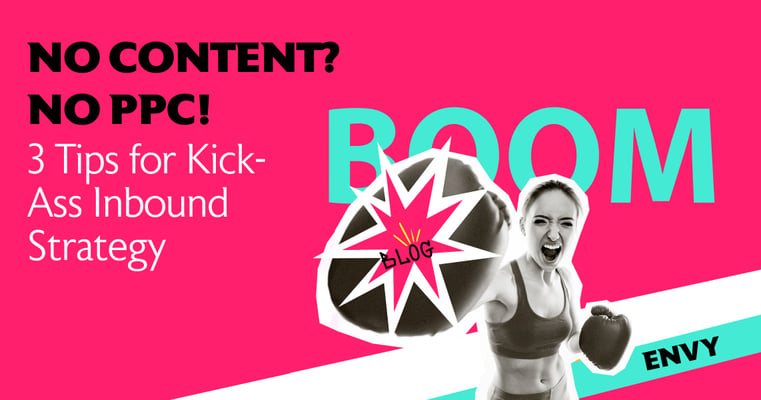
No content? No PPC! 3 Tips for Kick-Ass Inbound Strategy
Here’s an unpopular opinion you didn’t ask for: content is the lifeblood of any successful B2B PPC campaign. Without quality content, your campaigns fall flat, your audience disengages, and your conversion rates plummet. It’s a grim scenario that no marketer wants to face. And yet so many do…
What we’ve been seeing for so many years now as an experienced B2B PPC agency is many companies neglecting content as the lifeblood for their PPC… and then standing astonished by the poor results.
No content? No campaigns!
Apparently, 80% of business decision-makers prefer reading a series of articles to know more about a company than to see an advertisement or sponsored video. That’s exactly why effective PPC campaigns can’t just rely on eye-catching ads, but hinge on the value-rich content that supports those ads instead. Quality content fosters engagement, builds trust, and, ultimately, drives conversions. Isn’t that the goal?! But without content, even the most sophisticated PPC strategies can falter.
Still not convinced? Here’s how content drives your PPC campaigns in more detail:
- When users click on your PPC ads, they expect to land on a page that offers valuable information or solutions to their problems. High-quality content ensures that this expectation is met, fostering trust and encouraging further engagement. Without engaging content, users are likely to bounce; you’ve spent so much money on getting them to your landing page or asset and they’ve got no reason to walk around and look at more. That’s just wasting your ad spend!
- Content actually determines your Google Ads Quality Score. You’ve read that right, your Google ads’ performance is directly linked to the quality of your content. High-quality landing pages, filled with relevant and informative content, contribute to higher scores, which can lower your cost per click (CPC) and improve your ad placements;
- Consistently delivering valuable content helps establish your brand as an authority in your industry. This not only boosts your PPC efforts but also enhances your overall inbound strategy, attracting organic traffic and fostering long-term customer relationships.
3 Tips for Kick-Ass Inbound Strategy
Unlike outbound sales, inbound marketing was developed with the purpose of helping potential customers connect to your brand and the products or services you offer. The connection and trust are built slowly, over time, through valuable content such as blogs, emails, eBooks, videos, podcasts etc. It’s a multi-step and non-linear process that first makes potential customers aware of your business and then, draws those same potentials to your website and into your sales funnel.
Although inbound marketing is a long term strategy, it doesn’t mean you’ll be spending money without payback. The great thing about inbound is that you can start small and add on as you grow—you don't have to jump all-in all at once.
When all's said and done, the things you can expect from a successful inbound marketing strategy are:
- Long lasting, valuable traffic through organic and direct,
- Higher quality leads,
- Higher engagement rates,
- Stronger brand awareness.
So, how does PPC fit into your B2B inbound marketing strategy? It’s only through the combination of both strategies that you receive the best results. And here’s how you can get even more:
Kick-Ass Inbound Tip #0: Think full funnel
We just have to say this, and the reason why this isn’t one of the tips is, well, this isn’t a tip. This is a must. Planning and creating your content with your full-funnel campaign in mind can and will bring even better results. Content that aligns with each stage of the buyer's journey, presented in various formats–and that’s an important bit–will engage diverse audience preferences. After all, users who don’t know your brand at all and, what’s more, are not even aware of the problem they’re experiencing, won’t engage with your “book a demo” ads.
- At the top of the funnel, think attention-grabbing blog posts, infographics, and social media content serve to raise awareness and generate interest. This is where you'll start lead generation on LinkedIn for this–to gather leads you'll nurture as they move through their journey with you;
- As prospects move to the middle of the funnel, more detailed formats like whitepapers, case studies, and webinars provide the in-depth information needed to nurture leads and build consideration;
- Finally, at the bottom of the funnel, content such as product demos, testimonials, and comprehensive guides help to drive conversions by addressing final concerns and showcasing your solution's value.
Now, we’ve just said that your content should come in various formats. Why? Because the times when one single ad promoting one single ebook on one single platform are long gone. So reuse your content as much as you can: create blogs, social, videos, interviews, podcasts–all around one topic.
Now, let’s move to the actual tips.
Kick-Ass Inbound Tip #1: Remarketing
Remarketing is a hugely impactful PPC strategy and it’s a perfect fit with Inbound marketing. It allows you to tailor your online ads to specific prospects based on their browsing history as relevant to your business. You can target ads toward prospects who have visited your website, or you can be even more specific and only show ads to customers based on different actions taken on your website: viewing a particular service or signing up for your email list.
Remarketing campaigns are incredibly effective because they allow you to target people who are already familiar and might be interested in your brand, and reach out to them with messages appropriate to their stage in the inbound marketing funnel. It’s what us marketers like to call “low hanging fruit”. You have the opportunity to specifically target your messaging and communicate with prospects on a much more personal level.
You worked so hard bringing the right visitors to your site using great tailored content and social media engagement, but oh so few people actually will leave their details on the first go. Remarketing will enable you to bring back these users again and again, until they convert.
Let’s say you’re a cybersecurity company with a new product offering you want to get out there. The truth is, the best way to begin is with people who are already familiar with your service. Specifically target only the individuals who’ve visited your website during a certain time period or who made it to a particular page, such as your product page.
One thing we ought to say… remarketing does NOT mean bombarding users with the exact same ads over and over again. Analyze your previous content performance to see what worked best and follow that direction when creating new copy and new assets for improved results. You can even go to the next level by displaying ads featuring the exact products or services users viewed on your site
Kick-Ass Inbound Tip #2: Boosting Post-Exposure
Once your content is live, the work doesn’t stop (does it ever…) Maximizing the exposure and effectiveness of your content requires strategic SEO and distribution efforts. Here’s how to ensure your content reaches its full potential:
- During your B2B inbound marketing journey, you’ll create lots of content, if you haven’t already. Why not give your best content a small push and reach even more people to increase your engagement? By targeting demographics, interests, location, job titles, online behavior and more, you can provide valuable content to the maximum reach of prospects. Let’s go back to the cybersecurity company example. When you have a new service available, one of the first things you’re going to want to do is write a few blogs that outline your new product/service. Without PPC, finding readership for those new blogs, which you previously had no SEO or readership for, could take a long time. Yes, eventually (if you know your SEO), your prospects will find your website through organic search, but that means they were searching for you in the first place. What about the many times people don’t know they need your solution, or do, but don’t know what to search for. Post engagement allows you to get your word out to relevant prospects with relevant content that gives them value. It also shortens the time it takes and extends your reach in exactly the direction you want to go, which is particularly important for content that is timely and needs to reach a large audience, fast.
- And speaking of SEO….it goes without saying that SEO is critical for driving organic traffic to your content. While you’re at it, you might as well (and should) ensure that your content is keyword-rich, well-structured, and optimized for search engines. Use tools like Google Keyword Planner and SEMrush to identify high-impact keywords and incorporate them naturally into your content.
- Last but not least, let’s talk content distribution. We know more platforms means more money, yes, but if you’re unsure where your audience actually lives, there’s a chance you’re spending your bucks on the wrong platform. Share your content across various channels to increase visibility and engagement. And like we said above, use different forms of content too to amplify your reach and encourage sharing.
Kick-Ass Inbound Tip #3: Don’t Ignore Thought Leadership
Thought leadership is about positioning your brand as an expert in your field. It involves consistently producing high-quality content that offers unique insights and perspectives–and it’s a great way to boost your PPC efforts. Mind you, it’ll be a little bit more (okay, a lot more) resource consuming as opposed to launching an ad here and there, but it’ll be SO worth it. How?
- Publish valuable in-depth articles and social posts - explore industry trends, discuss overcoming challenges, consider innovations, offer valuable insights - all from your perspective as an expert. These should be backed by data and years of experience to provide real value to your audience. Plus, that’s what search engines will appreciate too 😉
- Host webinars and live events - there’s nothing more engaging than hanging out with your audience in real-time. Choose relevant topics, invite industry experts, and encourage interactive discussions to provide value and build authority–and then share content around these online using photos and video snippets to attract even more folks.
In the end, when it comes to your B2B inbound marketing strategy the only thing that matters is that you’re successful in bringing potential customers into your sales funnel, and PPC should be a key piece of that. Ready to take your inbound strategy to the next level? Start by integrating these tips into your marketing plan and watch your engagement and conversions soar. And if at any point that feels overwhelming… we’re here to help.




-2.jpg?width=352&name=ME%20-%20Blog%20Image%20-%20Holy%20Trinity%20NEW%20(3)-2.jpg)

